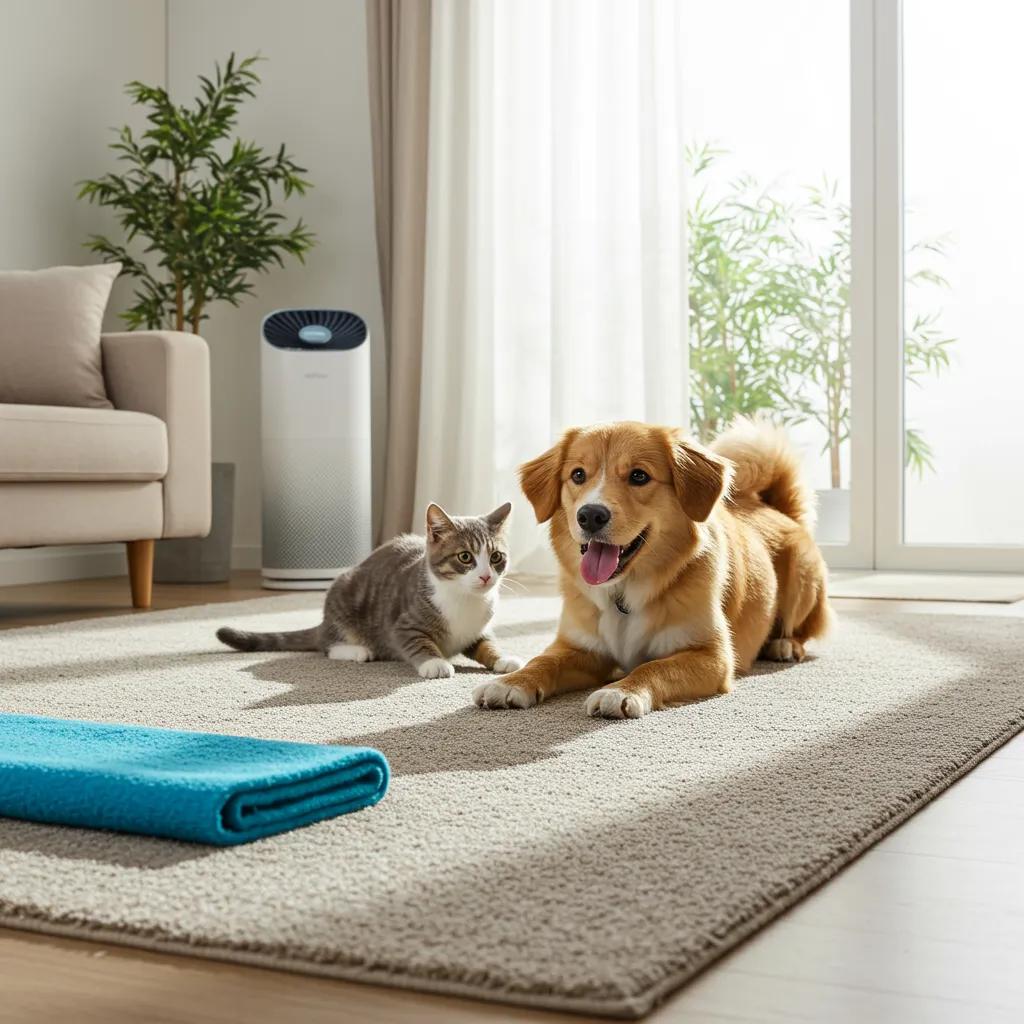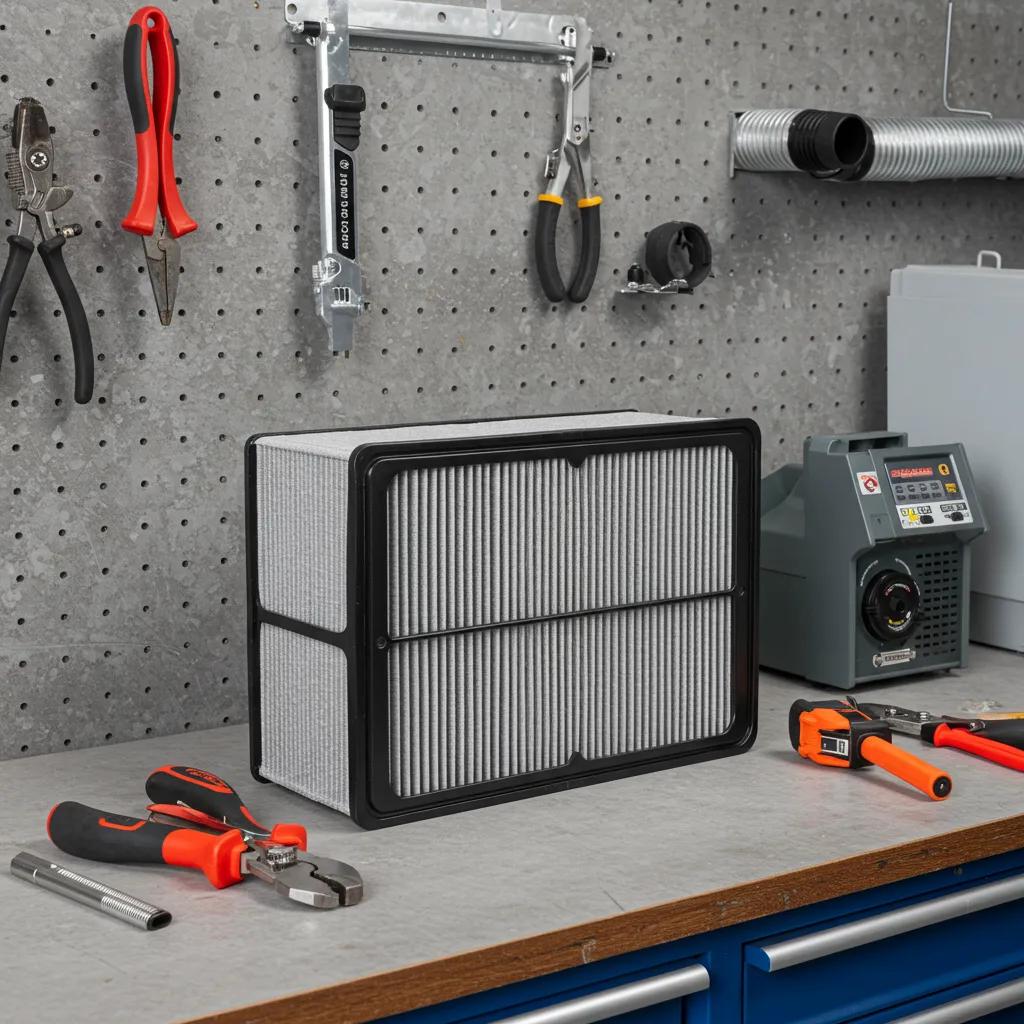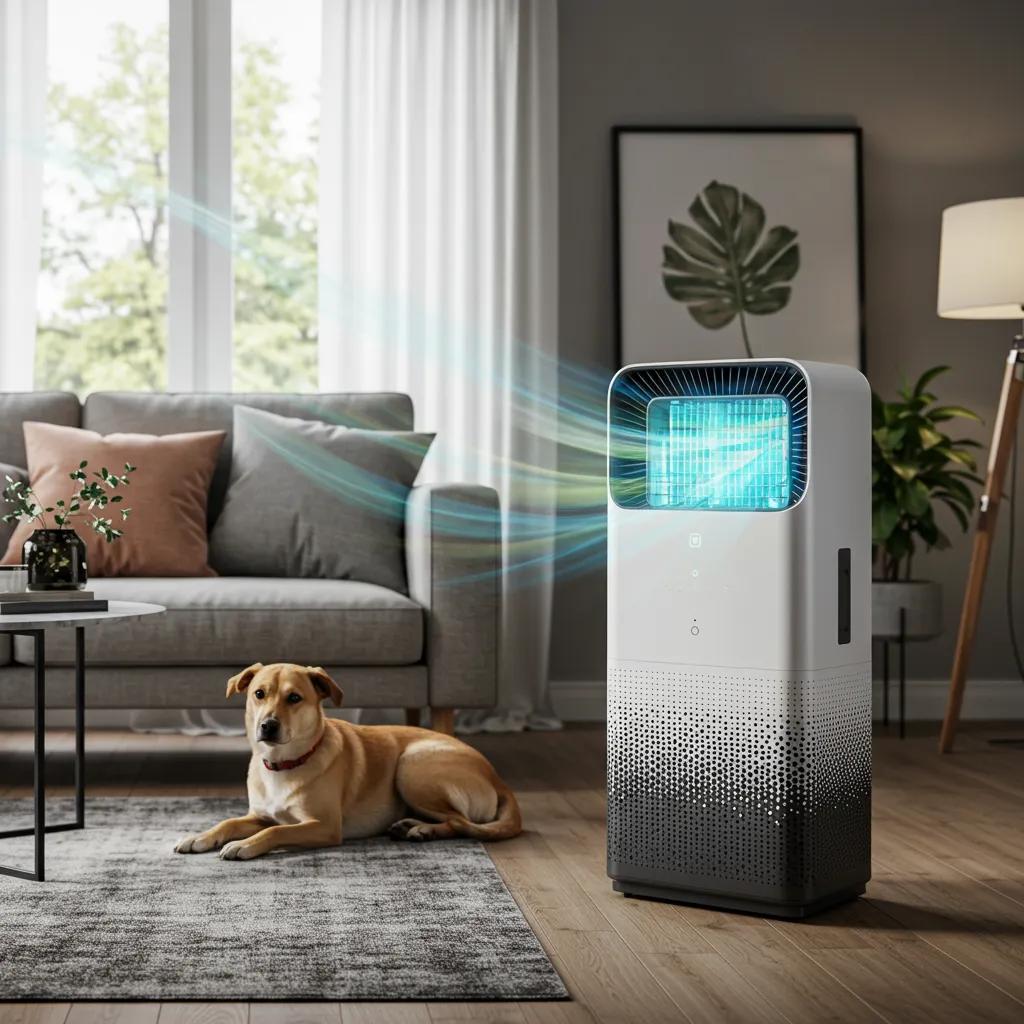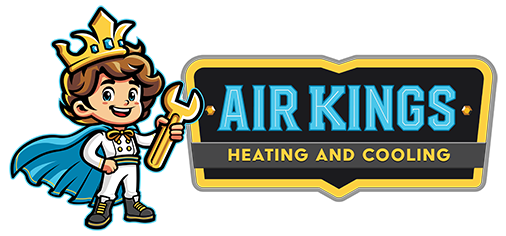
Banish Pet Dander: Your HVAC System's Role in a Breathable Home
Those tiny skin flakes your furry friends shed, known as pet dander, can settle into carpets, furniture, and even your HVAC system, leading to sneezes, wheezes, and constant congestion for allergy sufferers. Understanding how this dander interacts with your heating, ventilation, and air conditioning is your first step toward fresher indoor air and lasting relief. This guide breaks down what pet dander is, how it impacts your health, and the powerful HVAC strategies—like filtration, purification, duct cleaning, and humidity control—you can implement right away. You’ll discover which filters are best at trapping the smallest particles, how whole-home air purifiers integrate seamlessly with your existing ductwork, why professional duct cleaning is a game-changer, and what regular cleaning habits can boost your HVAC’s performance. Plus, learn how Air Kings Heating and Cooling, your local experts in Mundelein, IL, provide top-notch installation, maintenance, and honest service to help your family breathe easier.
What Exactly Is Pet Dander and How Does It Mess with Your Home's Air?
What Is Pet Dander and Why Does It Trigger Allergies?
Pet dander refers to the microscopic skin cells that animals like cats and dogs naturally shed. These particles carry proteins that can trick your immune system into thinking they’re invaders, sparking an allergic reaction. When you breathe them in, they cling to your mucous membranes, prompting your body to release histamine, which causes symptoms like itchy eyes or a stuffy nose. Because dander is incredibly small—often less than 10 microns—it can hang around in the air for a long time, making effective filtration absolutely crucial for relief.
How Does Pet Dander Lead to Allergy and Breathing Problems?
Coming into contact with pet dander can trigger allergic rhinitis and worsen asthma by irritating your airways. For those sensitive to it, inhaling these allergenic proteins can latch onto receptors in your nose and throat, leading to sneezing, coughing, and constricted breathing. Continuous exposure can ramp up mucus production and make your airways more sensitive, resulting in ongoing respiratory discomfort and a greater chance of getting sick. By controlling airborne dander with smart HVAC solutions, you can dial down this inflammatory response and protect your lungs.
Where Does Pet Dander Love to Hide in Your Home?
Pet dander doesn’t just sit on surfaces; it also makes itself at home within your HVAC components. While carpets, upholstered furniture, and curtains are common spots, hidden dander can lurk inside your air handler, ductwork, and filter housings. When your system kicks on, it circulates this trapped dander throughout your home, undoing your cleaning efforts. Pinpointing these hidden dander havens is key to developing a strategy that combines surface cleaning with HVAC maintenance for complete removal.
How Long Does Pet Dander Stick Around in Your House?
If left unchecked, pet dander can linger in your home for weeks or even months. Its persistence is due to its tiny size and its tendency to cling to dust and fabrics. Even after your pets are no longer in a particular area, residual dander in upholstery and ducts can keep circulating until you upgrade your filters and clean your ductwork. Regularly swapping out your HVAC filters and getting professional duct cleaning creates a barrier that stops old dander from recirculating and prevents new dander from settling in.
Which HVAC Filtration Systems Are Your Best Bet for Zapping Pet Dander?

What Are HEPA Filters and Why Are They So Great for Pet Allergies?
High-Efficiency Particulate Air (HEPA) filters are designed to capture an impressive 99.97% of particles as small as 0.3 microns. This means they effectively trap pet dander before it ever gets into your living spaces. These dense, multi-layered filters use mechanical means to stop allergens and dust mites in their tracks, promoting cleaner airflow. Installing HEPA filters in compatible air handlers can dramatically cut down on airborne irritants and help allergy sufferers breathe more comfortably. Their superior efficiency makes them the top choice for pet owners seeking real relief.
Research shows that air filtration systems can significantly reduce allergen exposure for people with pet allergies and asthma. Air filtration systems can significantly reduce allergen exposure for people with pet allergies and asthma.
Pet Allergen Control: Air Filtration for Asthma Management
Although pet removal has been recommended in guidelines for the management of allergic asthma, pet ownership remains high in families where one or more members have an allergy to pet dander. Allergen control measures, such as air filtration units placed in the homes of asthmatics with pet allergies, have been employed as a means of reducing allergen exposure.
Pet allergen control measures for allergic asthma in children and adults, 1996
How Do MERV Ratings Affect Pet Dander Capture?
MERV, or Minimum Efficiency Reporting Value, ratings range from 1 to 20 and tell you how well a filter can trap particles of different sizes. The higher the MERV rating, the finer the filtration and the better it is at capturing dander.
| Filter Rating | Particle Size Range | Dander Capture Efficiency |
|---|---|---|
| MERV 8 | 3–10 microns | Fair |
| MERV 11 | 1–3 microns | Good |
| MERV 13 | 0.3–1 microns | Excellent |
Opting for a filter with a MERV rating of 11 or higher can significantly reduce dander without putting too much strain on most HVAC blowers. Stepping up to a MERV 13 filter will capture almost all pet dander and pollen, making a huge difference in your indoor air quality and reducing allergy triggers.
How Often Should You Swap Out HVAC Filters to Keep Pet Dander in Check?
For homes with pets, changing your filter every 60 days is the sweet spot for optimal performance. High-efficiency filters tend to catch more debris, so timely changes are essential to maintain airflow and trapping power. Sticking to a regular schedule prevents pressure drops, lowers energy consumption, and stops trapped allergens from being released back into your air. Mark your calendar for a filter swap every two months to ensure pet dander doesn’t build up and recirculate through your HVAC system.
Can Air Kings Install and Maintain Top-Tier Filters for Pet Owners?
Air Kings Heating and Cooling excels at installing and servicing high-efficiency filters specifically designed for homes with pets. With over 100 years of combined HVAC expertise, our technicians will assess your system, recommend the best MERV or HEPA option, and set up a filter replacement schedule to keep things running smoothly. This dependable service enhances allergen control and ensures your indoor environment stays healthy and fresh, all backed by our honest, flat-rate pricing.
How Can Air Purifiers Help Cut Down on Pet Dander and Freshen Your Indoor Air?
What Kinds of Air Purifiers Are Best for Pet Allergy Sufferers?

Standalone air purifiers that feature HEPA filtration, activated carbon, and UV-C light offer a multi-pronged defense against pet dander, odors, and germs. The HEPA filter snatches up microscopic particles, activated carbon soaks up volatile organic compounds and smells, and UV-C lamps zap airborne bacteria and viruses. Choosing a purifier with a combination of these technologies ensures comprehensive allergen removal and odor control, creating a cleaner breathing space for allergy sufferers.
Studies confirm that various air filtration systems, including portable HEPA air cleaners, can significantly reduce cat allergens in the air and ease asthma symptoms.
Effectiveness of Air Filtration in Reducing Cat Allergens and Asthma Symptoms
The reduction of cat allergen in indoor air using various air filtration systems and portable devices has been demonstrated in the majority of studies. More recently, both early and late asthmatic responses were significantly reduced through the use of portable HEPA air cleaners within an environmental exposure chamber.
Does air filtration work for cat allergen exposure?, 2020
How Do Whole-Home Air Purification Systems Work with Your HVAC?
Whole-home air purifiers connect directly to your ductwork, using your existing blower to send purified air throughout your entire house. These systems typically include HEPA modules, carbon adsorbers, and UV-C chambers installed at the return or supply plenum. By treating all the air that flows through your system centrally, whole-home units provide consistent allergen capture, reduce the chances of dander buildup in tricky spots, and simplify maintenance with filter changes done in one place.
What Are the Latest Air Purifier Models Recommended for Pet Owners?
The top air purifier models for 2025 come equipped with smart sensors, app controls, and energy-efficient designs that automatically adjust fan speeds based on real-time air quality readings.
| Model Name | Key Feature | Benefit |
|---|---|---|
| PureAir Pro X200 | AI-powered sensor network | Automatic allergen detection |
| PetGuard Ultra 500 | Dual-stage HEPA & carbon filtration | Superior dander and odor elimination |
| ClearFlow Smart 4 | Voice-activated controls | Effortless home air management |
Choosing one of these advanced units means you’ll get targeted removal of pet dander, volatile compounds, and microbial threats, offering pet owners a high-performance solution that adapts to the daily changes in their indoor air.
How Can Air Kings Help with Air Purifier Installation and Upkeep?
Air Kings technicians will assess your ductwork setup and recommend the best whole-home purifiers or standalone units based on your home’s size and how many pets you have. Our installation process is designed to be as non-disruptive as possible and ensures your airflow is calibrated for optimal filter life. We also offer ongoing maintenance plans, including filter changes and performance checks, to guarantee your air purifier keeps working at its best and maintains clean, allergen-free air all year long.
Why Is Cleaning Your Air Ducts So Important for Getting Rid of Pet Dander?
How Does Pet Dander Build Up in Air Ducts and Impact Air Quality?
As air moves through your system, pet dander sticks to the inside of your ducts and collects in bends, vents, and plenums. Over time, this accumulated gunk can break loose and get blown back into your living spaces with every HVAC cycle. Dirty ducts essentially amplify allergen recirculation, making your filters less effective and keeping indoor dander levels high. Professional cleaning removes these hidden dander reservoirs and restores your ductwork’s integrity.
What Are the Perks of Professional Air Duct Cleaning for Pet Owners?
Professional duct cleaning gets rid of trapped dander, dust, and potential microbial growth, leading to:
- Better airflow and a more efficient system
- Less allergen recirculation and relief from symptoms
- Lower energy bills thanks to unobstructed ducts
Removing these deep-seated irritants also helps extend your HVAC system’s lifespan and promotes healthier indoor air, offering pet households tangible benefits in comfort and cost savings.
How Often Should Air Ducts Be Cleaned to Keep Pet Dander Under Control?
Homes with pets should plan for professional duct cleaning every 2–3 years. You might need more frequent service if allergy symptoms persist or if you’ve recently had renovations or generated a lot of dust. Regular maintenance prevents excessive buildup, ensures your filtration works effectively, and maintains consistent airflow, making it a cornerstone of comprehensive pet dander management.
What Does Air Kings’ Air Duct Cleaning Service Include?
Air Kings’ air duct cleaning involves high-velocity agitation inside your ducts, HEPA-grade vacuum extraction, and sanitization of registers and plenums. Our technicians monitor the process in real time, confirm all debris is removed, and optimize your system’s balance. This thorough approach eliminates pet dander hiding spots and prepares your HVAC system for efficient filtration and purification, leading to healthier indoor air.
What Home Cleaning Practices Work Best Alongside HVAC Solutions to Cut Down on Pet Dander?
How Does Regular Pet Grooming Help Minimize Dander?
Consistent grooming helps reduce loose hair and dead skin cells before they even have a chance to become airborne in your home. Brushing your pet weekly with tools designed to trap fine particles can slash airborne dander by up to 70%. Giving your pets regular baths with hypoallergenic shampoos also helps remove allergens right at the source, preventing them from getting deeply embedded in carpets and furniture. Combining grooming with targeted HVAC filtration significantly boosts your indoor air quality.
What Are the Top Vacuum Cleaners and Techniques for Tackling Pet Dander?
Vacuum cleaners equipped with HEPA filtration and sealed dust compartments are much better at capturing microscopic particles than standard models.
- Use specialized attachments for upholstery and tight corners.
- Vacuum high-traffic areas at least twice a week.
- Move your vacuum slowly with overlapping strokes to dislodge embedded dander.
Choosing a HEPA-certified vacuum and following a systematic cleaning routine prevents dander from being kicked back into the air and contributes to an overall reduction in airborne allergens.
How Can Managing Humidity Help Reduce Pet Dander and Allergens?
Keeping your indoor relative humidity between 40–50% helps airborne particles clump together, causing them to fall to surfaces instead of staying suspended in the air. Humidifiers add moisture during dry seasons, while dehumidifiers prevent mold and dust mites from thriving in humid climates. Balanced humidity not only slows down dander circulation but also eases dryness-related respiratory irritation, making your home more comfortable for everyone.
How Does Routine HVAC Maintenance Support Pet Dander Reduction Efforts?
Regular HVAC tune-ups keep your blowers, coils, and filter tracks clean, ensuring that your high-efficiency filters perform exactly as they should. Seasonal inspections help identify wear and tear, seal up any leaks, and confirm airflow rates, preventing unfiltered air from bypassing your system. Signing up for a maintenance plan with Air Kings guarantees scheduled service, priority repairs, and ongoing system optimization, reinforcing a proactive approach to allergen control.
How Can You Create a Pet Allergy-Friendly Home Using HVAC and Cleaning Strategies?
What Are the Advantages of HVAC Maintenance Plans for Allergy Sufferers?
A well-structured maintenance plan provides:
- Scheduled filter changes and performance checks
- Priority service for emergencies and system adjustments
- Consistent airflow and peak filtration efficiency
These proactive measures help prevent unexpected breakdowns and maintain effective allergen control, giving allergy sufferers peace of mind and predictable indoor air quality.
How Does Air Kings Deliver Dependable and Honest HVAC Services in Mundelein, IL?
As a local, family-owned business with over a century of combined experience, Air Kings Heating and Cooling blends time-tested craftsmanship with cutting-edge technology. Our technicians take the time to listen to your concerns, recommend personalized Indoor Air Quality solutions, and provide flat-rate pricing with absolutely no hidden fees. This transparent approach builds trust and ensures that every service call directly contributes to a healthier, more comfortable home for you and your family.
What Are Common Questions About Using HVAC Solutions to Remove Pet Dander?
Homeowners often ask about how often to change filters, which air purifier is best for homes with multiple pets, and when duct cleaning is necessary. Providing clear, evidence-based answers helps demystify these topics and guides informed decisions. Empowering yourself with this knowledge helps pet owners maintain allergy-friendly living spaces and highlights the value of professional support.
What Are the Best Ways to Permanently Reduce Pet Dander in Your Home?
How Can Combining HVAC Solutions with Home Cleaning Maximize Pet Dander Removal?
Integrating high-efficiency filtration, whole-home purification, and regular duct cleaning with consistent pet grooming, thorough vacuuming, and proper humidity control creates a comprehensive defense system. Each strategy tackles a different part of the dander lifecycle—from when it’s produced to when it floats in the air to when it settles—resulting in cumulative benefits that far surpass individual efforts. This multi-layered approach delivers lasting relief for allergy sufferers and ensures a consistently fresh indoor environment.
What Part Does Ventilation Play in Managing Pet Allergens?
Effective ventilation swaps out stale indoor air for fresh outdoor air, helping to dilute allergen concentrations. Mechanical ventilation systems, especially those with heat recovery, can exchange air while conserving energy, reducing the need to open windows, which can let in outside pollutants. Properly balanced ventilation prevents dander from accumulating in stagnant areas and supports overall Indoor Air Quality by maintaining continuous air movement.
How Can You Effectively Monitor Your Home's Indoor Air Quality for Pet Dander?
Portable air quality monitors can measure particulate matter and relative humidity in real time, giving you immediate feedback on allergen levels. Placing these monitors in your main living areas and bedrooms helps you see how cleaning activities or HVAC adjustments affect your air quality. Tracking these metrics over time can guide decisions about upgrading filters and confirm the effectiveness of your air purifiers and duct cleaning services.
Keeping your home’s air fresh and pet-friendly requires a smart, coordinated strategy that combines advanced HVAC technology with everyday cleaning habits. By using high-efficiency filters, installing whole-home purification systems, scheduling professional duct cleaning, and adopting consistent pet grooming routines, homeowners can significantly reduce airborne irritants and allergy triggers. When you partner with a trusted local expert like Air Kings Heating and Cooling, these measures provide lasting comfort, transparency, and peace of mind. Ensuring clear airflow and consistent maintenance means your family can breathe cleaner air today and for years to come.

